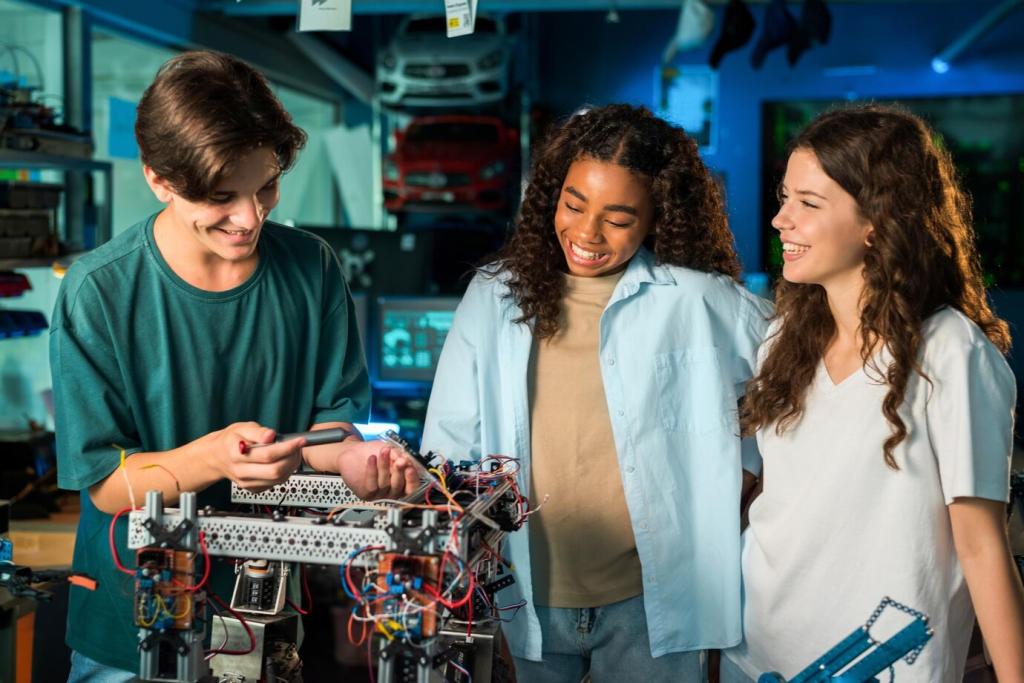
Creative Robotics Projects for Children
Chosen theme: Creative Robotics Projects for Children. Welcome to a playful hub where motors meet imagination, tiny circuits spark big ideas, and kids discover confidence through hands-on tinkering, storytelling robots, and joyful experiments you can try today at home or in class.
Getting Started: Tools, Safety, and Spark
Begin with a simple kit: small screwdriver, tape, craft sticks, binder clips, AA batteries, hobby motors, LEDs, and alligator clips. Label containers, add bright stickers, and keep a magnifying glass handy. Kids love inspecting gears up close and naming parts like tiny detectives on an engineering quest.

Tape an off-center weight, like a clip on a motor shaft, and watch the bot wobble across paper, drawing colorful spirals. Add googly eyes, a name, and a backstory. One seven-year-old named hers “Comet,” then wrote a comic about its secret mission to collect stardust confetti.
First Bots: Simple Projects That Wow
Use two light sensors to guide two tiny motors. When one side senses more light, that wheel spins faster, nudging the critter toward flashlights. Introduce playful experiments: dim the room, create shadow mazes, and ask children to predict paths. Curiosity blossoms when their predictions meet surprising motion.
First Bots: Simple Projects That Wow

This is the heading
Lorem ipsum dolor sit amet, consectetur adipiscing elit. Ut elit tellus, luctus nec ullamcorper mattis, pulvinar dapibus leo.

This is the heading
Lorem ipsum dolor sit amet, consectetur adipiscing elit. Ut elit tellus, luctus nec ullamcorper mattis, pulvinar dapibus leo.
Sensors as Superpowers
Compare bright windows, desk lamps, and flashlight beams with a light sensor. Add a clap sensor to trigger a celebratory LED. Challenge kids to invent routines: two claps for spinning, one clap for blinking. They discover cause and effect while giggling at perfectly imperfect robot applause.
Sensors as Superpowers
Create a touch pad using aluminum foil and tape, then tilt-controlled movement using a simple accelerometer. Ask children to design a robot game: tip left to dodge puddles, touch to pick flowers. Their narratives transform raw sensor numbers into lively scenes filled with agency and consequence.

Art + Robotics: STEAM Magic
01
Painting with Motors
Attach markers to a vibrating bot and test different weights, legs, and paper textures. Invite kids to title the artwork, then explain which adjustments changed the patterns. They learn iteration as artistry, discovering that technical tweaks can produce gentle swirls, bold bursts, or delicate meteor trails.
02
Wearable Light Stories
Sew simple LED circuits onto felt badges with conductive thread. Encourage storytelling: what does the glowing badge represent, and when should it light? A child crafted a “bravery star” that pulsed before show-and-tell, turning electronics into a comforting ritual anchored in personal meaning and pride.
03
Puppetry with Servos
Build a cardboard puppet whose eyebrows lift when a slider moves. Map emotions to servo angles—curiosity, surprise, determination—and script a micro-play. Families cheer when kids direct their robotic actors, learning that human feelings can guide technical decisions and transform mechanisms into expressive characters.
Troubleshooting as a Growth Mindset
Love Your Bugs
Create a “bug jar” poster. Each time something fails, kids draw the bug and write what they tried. When the solution appears, add a tiny cape to the bug. This playful tradition reframes errors as heroes, building confidence and resilience project after project.
The Post-It Test Plan
Write small tests on colorful notes: battery check, wire wiggle, code step, sensor tap. Execute them one by one, moving notes from “try” to “done.” Kids visualize progress, calm frustration, and celebrate each green checkmark, turning complex robotics into a series of friendly, doable steps.
Celebrate Tiny Wins
When a motor twitches or an LED finally blinks, pause and cheer. Ask, “What worked?” and “What should we try next?” Small victories fuel momentum. Encourage children to share wins with a photo or sentence, inviting supportive comments that nurture pride and community.
Community, Sharing, and Next Steps
Host a mini showcase at home. Kids present their robots, explain choices, and ask for ideas. Relatives join by video call, applauding thoughtful experiments. This gentle stage builds confidence and communication skills, proving every tinkerer has something meaningful to teach others.
Community, Sharing, and Next Steps
Try playful prompts: a robot that helps clean crayons, a light guardian for bedtime books, or a mailbox that waves. Rotate themes monthly, then compare designs. Invite readers to comment with variations, photos, or sketches so our community learns together, one joyful challenge at a time.
Community, Sharing, and Next Steps
Subscribe for fresh projects, printable guides, and seasonal challenges tailored to creative robotics projects for children. Vote on upcoming themes, ask questions, and share stories. Your ideas steer future builds, turning this blog into a collaborative workshop where young makers feel seen and supported.
